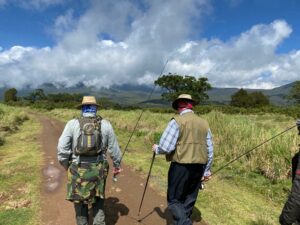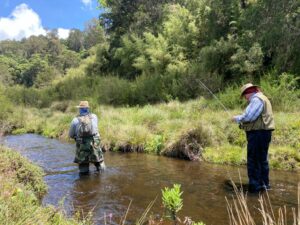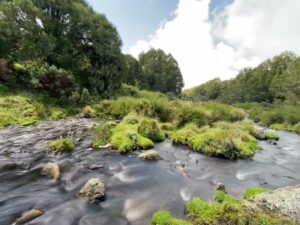I am slipping into middle age. I was recently invited to go fly fishing in Mount Kenya National Park. Not long ago this would have been politely but firmly turned down, but all of sudden fishing in Kenya sounded pretty adventurous. And as far as fishing goes, it was more adventurous and exciting than I had imagined.
So one week in October saw me knee-deep in meltwater, high up on Mount Kenya. While the rest of Kenya basked in tropical temperatures, up on the mountain we were just below the snow line and it was cold, but oh so beautiful.
Fly Fishing in Mount Kenya National Park
Click here to book this Mount Kenya accommodation
We based ourselves at Meru Mount Kenya Lodge, near Chogoria Gate and a half hour walk to prime fly fishing
The purpose of the trip was to go Fly Fishing in Mount Kenya National Park, now I have dabbled but am a novice beginner.
The area is for intermediate to advanced anglers. Not that I didn’t have a great time or felt overwhelmed, more slightly frustrated as I hone my skills to adapt to the different conditions you come across.
The river can be found within a fifteen to 20-minute walk from the camp. It meanders from uphill and down dale. Almost crossing over itself at times, it was running fast due to the recent heavy rains and we saw a range from muddy brown to crystal waters over our time. Deep and narrow to expansive and shallow, the rock-filled streams were around 2m average width and possibly 0.5 metre deep at best. Lined with gorse and tussocks they were fly hungry. A keen cast is required to avoid these, then avoiding the rocks and littered branches is your next challenge. Once you found a perfect spot to cast with the least interruptions, there were no fish.
Access to and along the river is more often than not via animal tracks through the shrubbery, mainly buffalo, littered with their mines, or the larger deposits from an elephant. There are certainly more animals than humans treading these paths. Other than on the main access road we didn’t come across another soul. We walked and walked, which in altitude and environment, often meant long days outside and exposed. We even managed to get a sunburn in the rain. Take hats and cream, the UV is strong.
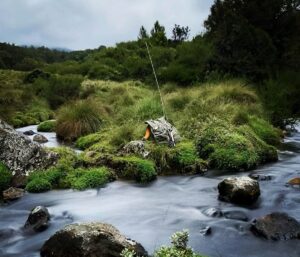
Fishing at Lake Ellis, Mount Kenya
We never made it to Lake Ellis which was several thousand feet further up Mount Kenya National Park. The roads were too muddy and the best way to get there is to walk. If you want to do it I suggest you pack light or hire a person to carry your bag, which can be arranged through Jevan at Meru Mount Kenya Lodge. An escort which ensures you don’t get lost, which is very easily done as there aren’t signposts here, and weather changes can easily disorient you. The ‘missing’ posters as you enter the camp will come back to remind you of this sad reality. Also worth noting, take a whistle! We had to use this at one point on our trip which was useful.
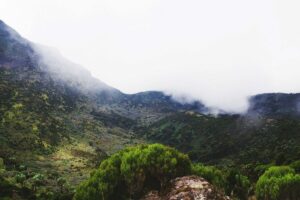
Mount Kenya National Park
Fly Fishing in Mount Kenya National Park is all about being in the great outdoors. The scenery was dramatic and magnificent for most of the time. Kenya has a habit of reminding you of other places. We could have been in the Scottish highlands one minute or the rivers of Colorado the next. The babbling rush of the water, the deafening silence whilst the mountain played peek-a-boo with you between drifting cloud formations.
That of course and fishing in Kenya with friends. I managed to catch my first wild rainbow trout, deeper cement relationships, and belly laugh into the evenings with tales of the one that got away. I guess it’s the middle-aged thing again that makes you appreciate those times and memories you are proactively creating.
The sense of connection to plug into nature as you unplug your devices also brings a wholesomeness and being ‘at the moment’ more frequently than we would care to admit. Looking after yourself, the complete responsibility. No shops, nothing but a raw adventure awaits.
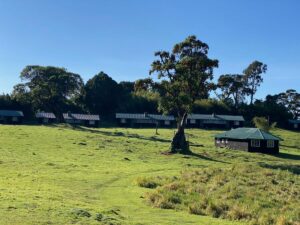
Accommodation on Mount Kenya
We stayed in Meru Mount Kenya Lodge a collection of huts at 3000 metres above sea level. They are easily accessed at Chogoria Gate.
The fishing and hiking accommodation on Mount Kenya is a simple affair, best described as log cabin-esque if you were being romantic, or a big shed if you were being harsh.
Meru Mount Kenya Lodge property has 5 cabins. We picked a two-bedroom ‘lodge’ further away from the other cabins, this became the home of three middle-aged bears for the 5 nights – human bears that drink whisky and snore.
You are greeted at the property by a stoep/porch, a space big enough for chairs and perfectly placed to spend many happy hours admiring the beautiful mountain vista. Our view was of shrubs and grasses tumbling down the hill towards the valley, with a backdrop of the rear slopes of Mount Kenya National Park. This view changed not even daily, but often hourly, highlighting some of the dangers in the mountains. Over our few days we saw mist, fog, cloud, overcast, lightning, hail, sun, and rain. What rain. Lots of rain.
The property is designed for people climbing and hiking Mount Kenya National Park, the huts are not luxurious in any way. You enter into a small lounge/diner with an open fire. The two bedrooms sit either side and they lead to the kitchen and bathroom.
The kitchen had a sink. The end. You bring the kitchen with you, just not the sink. To reiterate: No form of cooking is provided. No kettle, toaster, hob or cooker, no cups, dishes or plates.
The bathroom contained a toilet, sink, and bath with an overhead shower. Throughout our stay, there was no hot water. There was a problem with the Kuhne booster to this cottage. Therefore another of the cottages was provided for our showering needs. If the place is full this might not be viable.
The bedrooms were small but adequate for two sharing, with two single beds and bedding; where it was so dark it mattered not if your eyes were open or shut.
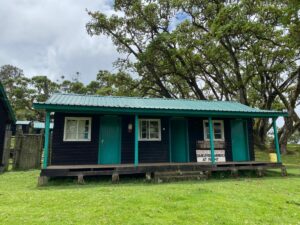
Facilities for climbers and hikers on at Meru Mount Kenya Lodge
Heating
The ability to have warmth is essential as it can be bitterly cold on Mount Kenya. When you return after being caught in a downpour, you need to be warm quickly as well as have the ability to dry your clothes.
Wood was provided but without copious amounts of kerosene we wouldn’t have gotten the wet wood logs provided alight. The staff on-site are responsible to light your fire but we soon took over this role.
Showering
Staff are responsible to ensure there is hot water for you. It takes a long time to heat so either request a shower time in advance or be prepared to wait hours. We had a hot to warm shower, at least once a day., just not always when we wanted it.
Cooking
There are no cooking facilities beyond a braai / BBQ outside the hut. We brought a portable gas stove and it was a lifesaver. There is no fridge/freezer so if you are up there for more than a few days you need to find a way to keep food cold. We brought a cool box and packed it with ice and it lasted over a week.
Mobile phones:
There is no mobile phone signal at all. We took a satellite phone for emergencies. This can become an issue when expected to pay for lodging and park fees so make sure to bring cash
Staff at Meru Mount Kenya Lodge
Two members of staff manned the camp. Jevan, the manager and Benson. They were amiable but slow. They will fetch hot water, accompany you to the river if you are worried about the wild animals and for an extra fee bag carry for your if you are planning on hiking a fair distance.
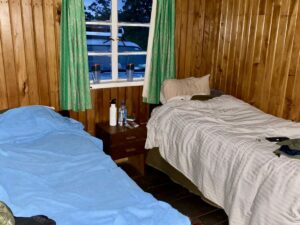
Driving to Meru Mount Kenya Lodge
Mount Kenya National Park is 200 km north of Nairobi. Well, paved roads lead to the nearby towns of Naro Moru (west side), Chogoria (east side) and Nanyuki (north side). From these locations, roads and tracks (approx. 20-30 km in length) lead up to the three main road heads and the park gates. Some of these are often in very poor condition, necessitating a 4-wheel drive vehicle, or walking. The roads to Met Station from the Naro Moru Gate and to Old Moses from the Sirimon Gate are passable without a 4wd vehicle.
The road to Meru Mount Kenya Lodge is decent. A gravel road possibly accessible by car during the dry seasons but requiring 4×4 for comfort and an assurance you will reach your destination. Make sure your car is tip-top before you leave, as the altitude will accentuate any starting problems. Driving outside the camp mountain wards was not suitable at this time of year (October). Even with 2 generations of new and old Prado’s.
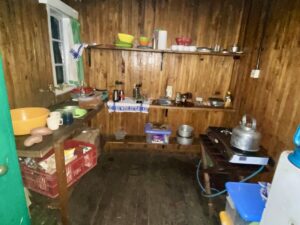
Altitude Sickness on Mount Kenya
It’s all about your altitude darling. It’s 3000m, 3km up in the sky. Mount Kenya is responsible for a large proportion of the world’s high altitude pulmonary oedema cases (a potentially fatal form of High Altitude sickness). Now, 3000m shouldn’t be a problem for those acclimatized to Nairobi’s 2000 metres but if you are coming straight in from sea level then you need to allow a couple of days to adjust. I recommend a few days in Nanyuki first. As Nairobian’s we found the oxygen noticably less – everything is just that much more of an effort. Be careful go slowly. You will be out of breath far quicker than you realise.

Information on Mount Kenya National Park
Mount Kenya was named a UNESCO World Heritage Site in 1997 and is referred to as “one of the most mpressive landscapes in Eastern Africa with its rugged glacier-clad summits, Afro-alpine moorlands and diverse forests that illustrate outstanding ecological processes”.
The second highest mountain in Africa, after Kilimanjaro, is an extinct volcano that last erupted between 2.8 to 3.2 million years ago. The elevation range is approximately 2200 metres to 5200 metres. Mount Kenya is a National Park and a National Reserve and as such is managed by Kenya Wildlife Service (KWS).
In the 2800 sq km, Mount Kenya National Park and National Reserve there is over 800 different species of plant life, some found nowhere else int he world. There is also a huge variety of wildlife such as elephant, buffalo, eland, bushbuck, waterbuck, zebra, hyena, colobus monkey, leopard, bongo, giant forest hog and rhino.
Mount Kenya is just one of many awe inspiring places to visit in the Laikipia region. Safari at Ol Pejeta which is home to all the Big 5 and the last two remaining northern white rhinos in the world. Visit the Trout Tree Restaurant where you can fish for farmed trout and enjoy a fishy meal for lunch or spend a weekend at the divine Castle Farm Lodge a log cabin at the foot of the mountain
What equipment to bring to Mount Kenya
Nights on Mount Kenya can be cold and wet even in the summer. There is often heavy rain and snow but violent storms are rare.
You must bring appropriate gear; bring wool and synthetic insulated materials are preferable to cotton or down.
There is little in the way of camping, hiking or fishing equipment in Kenya. Game does a few basic items, for everything else I buy abroad and ship it in. Something Random ships items in according to weight and with duty included. (No affiliate partnership just a recommendation of a good shipping company.)
Bring a map, compass, food, water, first aid kit, warm and waterproof clothing (available from Decathlon in Kenya), a signaling mirror, matches/lighter and a flashlight are essential. It is easy to think that you won’t get separated but you easily can. I did, and believe me when you’re all alone on the mountain it’s pretty scary.
For the huts bring a thick sleeping bag. Game sells sleeping bags but they are only down to 10 degrees and not warm enough for a night on the mountain. Ship in this excellent Hyke and Byke bag.
A stove, cooking items, plates, cups and cutlery. Lamps and lighting (preferably solar lights, easily picked up from petrol stations in Kenya or from Aliexpress here), Kersone and a way to keep your food and drink cold or frozen.
Mount Kenya National Park Fees
As part of the KWS network of parks and conservancies access to Mount Kenya requires standard fees. See image for the full list
Residents per day 300 KSH / 3 USD
Non residents 2000 KSH / 20 USD
Vehicles 300 KSH/ 3 USD
Mount Kenya National Park animals
Mount Kenya animals are numerous. The second highest mountain in Africa is a wild place, run as a park by the KWS. Many wild animals make the mountain their home. There are dik dik’s, waterbuck, bushbuck, monkeys, Franklin fowl and grouse. And there are dangerous animals such as Buffalo, hyena, leopard and elephant. We were lucky enough to spot some of these but evidence of them was all around us. At night the hyena howled and in the morning tracks and dropping were all around the camp. This was a place to keep your wits about you, not only in the huts but when walking in the vicinity. Talking, frequently clapping or making a ‘hooting’ sound while hiking through the forest zones warns animals you are approaching and they should move away from you.
If you do happen upon a dangerous animal then remain calm. If it’s an elephant or buffalo I strongly suggest you back away.
Emergency procedures on Mount Kenya National Park
In case of an emergency contact a KWS official immediately. The Ranger Station the head of the Teleki Valley and Austrian Hut are permanently manned as is the Met Station and the Naro Moru, Sirimon and Chogoria Gates. All have radios. You will also find assistance at Mackinder’s Hut in the Teleki Valley and Shiptons Hut in the Mackinders Valley.
Contact details for Mount Kenya accomodation
Meru Mount Kenya Lodge is privately owned and very cheap.
Click here to book this Mount Kenya tour
Credit: Source link
